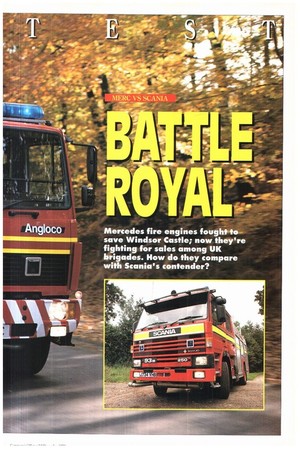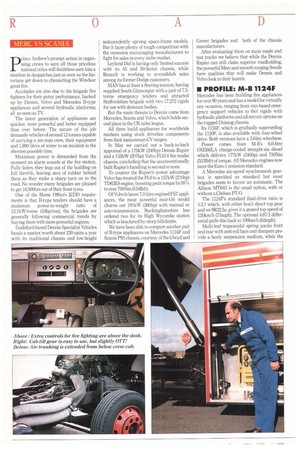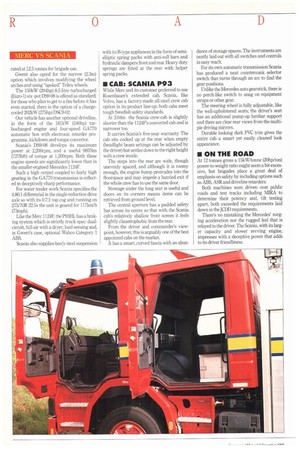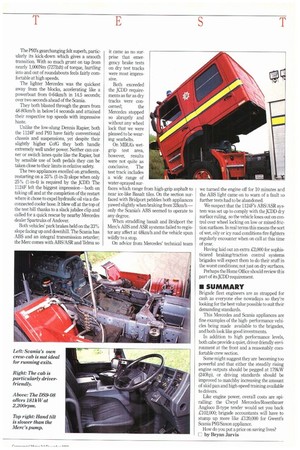Mercedes fire engines fought to save Windsor Castle; now they're
Page 29

Page 30

Page 31

Page 32

Page 33

If you've noticed an error in this article please click here to report it so we can fix it.
fighting for sales among UK brigades. How do they compare with Scania's contender?
Prince Andrew's prompt action in organising crews to save all those priceless national relics will doubtless earn him a mention in despatches just as soon as the historians get down to chronicling the Windsor great fire.
Accolades are also due to the brigade fire fighters for their gutsy performance, backed up by Dennis, Volvo and Mercedes B-type appliances and several hydraulic platforms; all as seen on TV.
The latest generation of appliances are quicker, more powerful and better equipped than ever before. The nature of the job demands vehicles of around 12 tonnes capable of carrying a six-man crew, their equipment and 1,800 litres of water to an incident in the shortest possible time.
Maximum power is demanded from the moment an alarm sounds at the fire station. Fully laden, they leap out of the building on full throttle, leaving arcs of rubber behind them as they make a sharp turn on to the road. No wonder many brigades are pleased to get 16,000km out of their front tyres.
One of the Home Office's JCDD requirements is that B-type tenders should have a minimum power-to-weight ratio of 12.1kW/tonne (16hp/ton); the brigades are generally following commercial trends by buying them with more powerful engines.
Guildford-based Dennis Specialist Vehicles heads a market worth about 230 units a year with its traditional chassis and low-height independently sprung space-frame models. But it faces plenty of tough competition with the recession encouraging manufacturers to fight for sales in every niche market.
Leyland Daf is having only limited success with its 45 and 50-Series chassis, while Renault is working to re-establish sales among its former Dodge customers.
MAN has at least a fleeting interest, having supplied South Glamorgan with a pair of 7.5tonne emergency tenders and attracted Staffordshire brigade with two 17272 rigids for use with demount bodies.
But the main threats to Dennis come from Mercedes, Scania and Volvo, which holds second place in the UK sales league.
All three build appliances for worldwide markets using stock driveline components from their mainstream CV ranges.
In May we carried out a back-to-back appraisal of a 179kW (240hp) Dennis Rapier and a 152kW (207hp) Volvo FL614 fire tender chassis, concluding that the unconventionally built Rapier's handling is second to none.
To counter the Rapier's power advantage Volvo has treated the FL 6 to a 157kW (210hp) TD63ES engine, boosting peak torque by16% to over 700Nm (5161bft).
Of Volvo's latest 7.0-litre engined FS7 appliances, the most powerful near-Gti model churns out 191kW (260hp) with manual or auto-transmission. Buckinghamshire has ordered two for its High Wycombe station which is bracketed by steep hillclimbs.
We have been able to compare another pair of B-type appliances on Mercedes 1124F and Scania P93 chassis, courtesy of the Clwyd and Gwent brigades and both of the chassis manufacturers.
After evaluating them on main roads and test tracks we believe that while the Dennis Rapier can still claim superior roadholding, the powerful Merc and smooth surging Swede have qualities that will make Dennis and Volvo look to their laurels.
• PROFILE: MB 1124F
Mercedes has been building fire appliances for over 90 years and has a model for virtually any occasion, ranging from van-based emergency support vehicles to 6x4 rigids with hydraulic platforms and all-terrain options on the rugged Unimog chassis.
Its 1124F, which is gradually superseding the 1120F, is also available with four-wheel drive. Both versions have a 3.64m wheebase.
Power comes from M-B's 6.0-litre 0M366LA charge-cooled straight-six diesel which delivers 177kW (240hp) and 750Nm (5531bft) of torque. All Mercedes engines now meet the Euro-1 emission standard.
A Mercedes six-speed synchromesh gearbox is specified as standard but most brigades seem to favour an automatic. The Allison MT643 is the usual option, with or without a Chelsea FT-0.
The 1124F's standard final-drive ratio is 4.3:1 which, with either box's direct top gear and on 9R22.5s, gives it a geared top speed of 1201un/h (75mph). The optional 4.87:1 differential pulls this back to 1001cm/h (62mph).
Multi-leaf trapezoidal spring packs front and rear with anti-roll bars and dampers provide a beefy suspension medium, while the dual-circuit full-air brake system comes complete with air dryer and load sensing.
The brakes are backed up by two "quickfill" large capacity reservoirs which, if empty on initial startup, will store enough air in their smaller compartments to release the service brakes within 10-12 seconds. Once 6.7bar is reached an overflow valve allows them to continue filling to 10bar.
In addition to the standard 12V alternator, a Powermite 110V generator is fitted for auxiliary equipment.
Clwyd laid out an extra £3,382 on a Telma electromagnetic retarder and £2,004 for integrated Wabco ABS with acceleration skid control (ASR) systems.
It also wanted extra locker space on the Angloco bodywork, which is why the standard wheelbase was stretched to 4.0m.
The four-stage retarder operates automatically on brake pedal application, and as the ABS detects a slip condition (or develops a fault) an interface unit cuts out the retarder.
This is hardly a cheap option but its driveline braking enhances the performance of the service brakes considerably and prolongs their effectiveness too.
• CAB: M-B 1124F
The Rosenbauer conversion to the LN2 cab is roomy, offering a flat floor, good head and legroom and excellent forward visibility through a full-width opening into the forwardsection. Two large roof lights illuminate the rear. It is austere but well finished; the front section is to Merc's usual high standard.
Wide, evenly-spaced steps provide the equipped crew with an easy, running exit. Its overall access dimensions make it one of the largest we have encountered and it has a clean practical interior too.
At Mercedes' request Rosenbauer replaced the original cab tilt device with something a bit sturdier, "to take account of the extra weight".
The big five-stage ram with electrohydraulic pump comes straight out of the Unimog parts catalogue. It may be a case of using an axe to crack eggs, but it does operate quickly and effectively. It raises to reveal an auxiliary start button on the engine.
In such a well suspended chassis and cab, Mercedes' own fully adjustable driver's seat proves quite comfortable. Not so its fore-andaft adjuster, which protrudes into the leg space where the engine stop button is located.
Behind the none-too-large steering wheel, switches and instruments are sensibly placed in order of importance, with heating and ventilation controls fanning out to the left of the main lighting switch.
Only the gearbox oil temperature in the header panel seems ill-positioned and we were surprised by the lack of a clock.
The Allison gear control with its reverse position to the fore is to the driver's left. It features a Morse-type shift which cab be customised to suit customer requirements: some London brigades have reverse to the rear, for example.
• PROFILE: SCANIA P93
Scania is another manufacturer which builds two and four-wheel-drive B-type appliances, along with a range of specials such as the five Carmichael-equipped P9311K4x4R-250 RIVs ordered for the Queen's Flight.These are rated at 17 tonnes and take a crew of three.
Our P9311L subject vehicle is a standard Bspec built with Saxon bodywork for the Gwent brigade, which no doubt specifies its equipment just as carefully as the Queens Flight firefighters. Gwent's P93 is based on a 16.6-tonne,3.8m-wheelbase chassis but is rated at 12.5 tonnes for brigade use.
Gwent also opted for the narrow (2.3m) option which involves modifying the wheel arches and using "spoked" Trilex wheels.
The 150kW (204hp) 8,5-litre turbocharged (Euro-1) six -pot DS9-08 is offered as standard; for those who plan to get to a fire before it has even started, there is the option of a chargecooled 202kW (275hp) DSC9-02.
Our vehicle has another optional driveline, in the form of the 181kW (246hp) turbocharged engine and four-speed GA770 automatic box with electronic retarder programme, kickdown and torque convertor.
Scania's DS9-08 develops its maximum power at 2,200rpm, and a useful 985Nm (7271bft) of torque at 1,200rpm. Both these engine speeds are significantly lower than in the smaller-engined Mercedes 1124F.
Such a high output coupled to fairly high gearing in the GA770 transmission is reflected in deceptively sharp performance.
For water tender work Scania specifies the 4.86:1 differential in the single-reduction drive axle so with its 0.7:1 top cog and running on 275/70R 22.5s the unit is geared for 117krn/h (73mph).
Like the Merc 1124F, the P93HL has a braking system which is strictly truck spec: dualcircuit, full-air with a dryer; load sensing and, in Gwent's case, optional Wabco Category 1 ABS.
Scania also supplies beefy steel suspension with its B-type appliances in the form of semielliptic spring packs with anti-roll bars and hydraulic dampers front and rear. Heavy duty springs are fitted at the rear with helper spring packs.
• CAB: SCANIA P93
While Merc and its customer preferred to use Rosenbauer's extended cab, Scania, like Volvo, has a factory-made all-steel crew cab option in its product line-up: both cabs meet tough Swedish safety standards.
At 3.04m the Scania crew-cab is slightly shorter than the 1124F's converted cab and is narrower too.
It carries Scania's five-year warranty. The cab sits cocked up at the rear when empty (headlight beam settings can be adjusted by the driver) but settles down to the right height with a crew inside.
The steps into the rear are wide, though unevenly spaced, and although it is roomy enough, the engine hump protrudes into the floorspace and may impede a hurried exit if the whole crew has to use the same door.
Stowage under the long seat is useful and doors on its corners means items can be retrieved from ground level.
The central aperture has a padded safety bar across its centre so that with the Scania cab's relatively shallow front screen it feels slightly claustrophobic from the rear.
From the driver and commander's viewpoint, however, this is arguably one of the best appointed cabs on the market.
It has a smart, curved fascia with an abun
dance of storage spaces. The instruments are neatly laid out with all switches and controls in easy reach.
For its own automatic transmission Scania has produced a neat countersunk selector switch that turns through an arc to find the gear positions.
Unlike the Mercedes auto gearstick, there is no perch-like switch to snag on equipment straps or other gear.
The steering wheel is fully adjustable, like the well-upholstered seats; the driver's seat has an additional pump-up lumbar support and there are clear rear views from the multiple driving mirrors.
Durable looking dark PVC trim gives the entire cab a smart yet easily cleaned look appearance.
• ON THE ROAD
At 12 tonnes gross a 15kW/tonne (20hp/ton) power-to-weight ratio might seem a bit excessive, but brigades place a great deal of emphasis on safety by including options such as ABS, ASR and ciriveline retarders, Both machines were driven over public roads and test tracks including MIRA to determine their potency and, tilt testing apart, both exceeded the requirements laid down in the JCDD requirements.
There's no mistaking the Mercedes' surging acceleration nor the rugged feel that is relayed to the driver. The Scania, with its larger capacity and slower revving engine, impresses with a deceptive power that adds to its driver friendliness. The P93's gearchanging felt superb, particularly its kick-down which gives a smooth transition. With so much grunt on tap from nearly 1,000Nm (7271bft) of torque, hurtling into and out of roundabouts feels fairly comfortable at high speeds.
The lighter Mercedes was the quickest away from the blocks, accelerating like a powerboat from 0-64km/h in 14.5 seconds; over two seconds ahead of the Scania.
They both blasted through the gears from 48-80km/h in belowl4 seconds and attained their respective top speeds with impressive haste.
Unlike the low-slung Dennis Rapier, both the 1124F and P93 have fairly conventional chassis and suspensions, yet despite their slightly higher CofG they both handle extremely well under power. Neither can corner or switch lanes quite like the Rapier, but by sensible use of both pedals they can be taken close to their limits in relative safety.
The two appliances excelled on gradients, restarting on a 33% (1-in-3) slope when only 25% (1-in-4) is required by the JCDD. The 1124F left the biggest impression—both on taking off and at the completion of the restart where it chose to expel hydraulic oil via a disconnected cooler hose. It blew off at the top of the test hill thanks to a slack jubilee clip and called for a quick rescue by nearby Mercedes dealer Spartruks of Andover.
Both vehicles' park brakes held on the 33% slope facing up and downhill. The Scania has ABS and an integral transmission retarder; the Merc comes with ABS/ASR and Telma so it came as no surprise that emergency brake tests on dry test tracks were most impressive.
Both exceeded the JCDD requirements as far as dry tracks were con cerned; the Mercedes stopped so abruptly and without any wheel lock that we were pleased to be wearing seatbelts.
On MIRA's wetgrip test area, however, results were not quite as conclusive. The test track includes a wide range of water-sprayed surfaces which range from high-grip asphalt to near ice-like Basalt tiles. On the section surfaced with Bridport pebbles both appliances yawed slightly when braking from 321an/h — only the Scania's ABS seemed to operate to any degree.
When straddling basalt and Bridport the Merc's ABS and ASR systems failed to register any affect at 48km/h and the vehicle spun wildly to a stop.
On advice from Mercedes' technical team we turned the engine off for 10 minutes and the ABS light came on to warn of a fault so further tests had to be abandoned.
We suspect that the 1124F's ABS/ASR system was set up to comply with the JCDD dry surface ruling, so the vehicle loses out on control over wheel locking on low or mixed-friction surfaces. In real terms this means the sort of wet, oily or icy road conditions fire fighters regularly encounter when on call at this time of year.
Having laid out an extra £2,000 for sophisticared braking/traction control systems brigades will expect them to do their stuff in the worst conditions; not just on dry surfaces.
Perhaps the Home Office should review this part of its JCDD requirement.
• SUMMARY
Brigade fleet engineers are as strapped for cash as everyone else nowadays so they're looking for the best value possible to suit their demanding standards.
This Mercedes and Scania appliances are fine examples of the highperformance vehicles being made available to the brigades, and both look like good investments.
In addition to high performance levels, both cabs provide a quiet, driver-friendly environment at the front and a reasonably comfortable crew section.
Some might suggest they are becoming too powerful and that either the steadily rising engine outputs should be pegged at 179kW (240hp), or driving standards should be improved to matchby increasing the amount of skid pan and high-speed training available to drivers.
Like engine power, overall costs are spiralling: the Clwyd Mercedes/Rosenbauer Angloco B-type tender would set you back £102,000; brigade accountants will have to stump up more like £120,000 for Gwent's Scania P93/Saxon appliance.
How do you put a price on saving lives?
C by Bryan Jarvis












































































